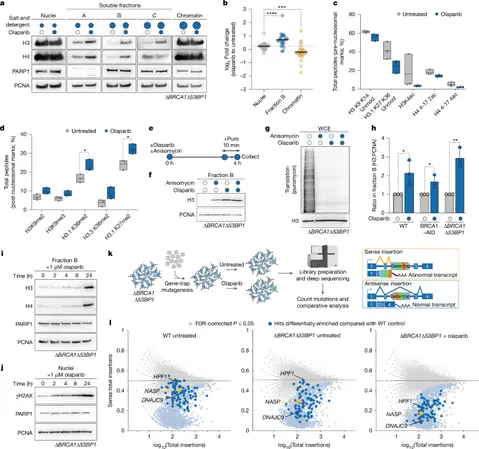T4K3.news
NASP histone turnover ties PARPi resistance
New findings link PARP inhibitor induced histone eviction to NASP turnover, suggesting a new path to overcoming resistance.

A new study shows PARP inhibition triggers histone eviction from chromatin and NASP helps maintain histone balance, revealing a potential target to overcome PARP inhibitor resistance.
NASP modulates histone turnover to drive PARP inhibitor resistance
PARP inhibitors have transformed treatment for homologous recombination deficient cancers, but resistance remains a hurdle. A new study shows that PARP inhibition triggers histone eviction from chromatin, revealing a vulnerability in PARPi resistant cells that rely on histone supply pathways to sustain high DNA replication rates. The researchers used genetic screens to identify NASP as a key histone chaperone that stabilizes evicted histones through its TPR motifs. They found that removing NASP makes tumor cells hypersensitive to PARPi in lab dishes and animal models, disrupts replication fork progression, and raises replication-associated DNA damage. NASP appears to work with the INO80 remodeling complex and PARP1’s chaperone activity to balance histone turnover and prevent lethal damage. The work positions histone eviction as an immediate cellular response to PARPi and suggests that targeting histone supply could help overcome resistance.
Despite the promise, translating these insights into patient care will require careful testing. Histone supply pathways are active in normal cells too, so therapies must spare healthy tissue. The study frames a new therapeutic angle that could complement existing strategies like PARP inhibitors and polymerase theta inhibitors. If confirmed in further studies, doctors may gain a new lever to prevent or delay resistance and researchers may explore drug combinations that disrupt histone turnover in tumors.
Key Takeaways
"PARP inhibitor treatment triggers histone release from chromatin"
A core experimental finding about chromatin response to PARPi
"Loss of NASP renders tumour cells hypersensitive to PARPi"
Demonstrated by in vitro and in vivo experiments
"Targeting histone supply pathways could overcome PARPi resistance"
Editorial takeaway from the study
"This chromatin angle could reshape how we approach resistance in HR-deficient cancers"
Broader implication for cancer therapy
The finding shifts attention to the early chromatin changes induced by PARP inhibitors rather than their later effects. Showing histone eviction as a direct response suggests a second set of targets in the chromatin repair machinery. Targeting NASP or the INO80-PARP1 axis could create a synthetic vulnerability, but it also challenges researchers to navigate potential effects on normal cells during DNA replication.
This work fits a broader trend in cancer therapy: resistance often hinges on fine cellular balances. Tumors that survive PARPi may rely on precise histone dynamics and chromatin remodeling; disrupting these dynamics could restore sensitivity. Real-world use will demand biomarkers to identify patients who benefit and rigorous safety testing to avoid collateral damage in healthy tissue.
Highlights
- Histone supply is the new vulnerability PARPi resistant tumors fear
- NASP loss turns PARPi resistance into a liability
- Chromatin control becomes a frontline in fighting resistance
- A histone chaperone opens a fresh path to therapy
The chromatin story is only starting to unfold and will test its clinical potential in the years ahead.
Enjoyed this? Let your friends know!
Related News

Study on super agers reveals brain traits and social links

IRS leadership shakeup

Cardano secures $70 million for network upgrades

Seven plant-based desserts promote gut health

Crypto market experiences sharp weekly gains and losses

Israel strikes Syrian forces in Suweida city

Russia holds firm ahead of Putin Trump summit

Russia Builds a Wartime Edge
